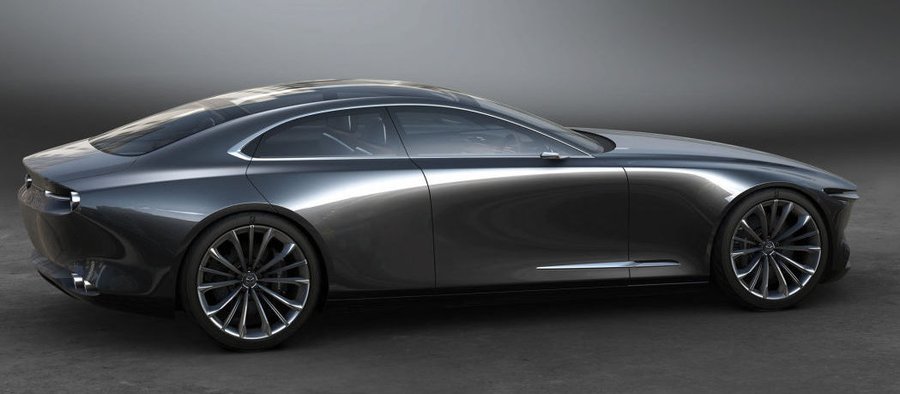Once the favored engine configuration for luxury and high-performance cars, the inline-six suffered a bit when the transverse (east-west) engine configuration became popular during the shift to front-wheel drive cars. The packaging benefits are obvious – no driveshaft or transmission intruding on passenger space or rear differential on cargo volume, plus turning the engine 90 degrees meant the front of the car could be shorter. But the inline-six is slowly, slowly crawling out of near-obsolescence, notably in BMW, Jaguar-Land Rover and Mercedes-Benz products. Add Mazda to that mix: An investor report first spotted by Jalopnik and confirmed by Mazda reveals that the company is developing a Skyactiv-X and Skyactiv-D inline-six that will be installed longitudinally (north-south) in a new "Large Architecture" platform.
Before reading any further, let's catch up on the Skyactiv-X and -D technologies. The former basically burns gasoline like diesel, providing some benefits and advantages of both types of combustion - here's an explainer on how that all works. We drove a prototype 2.0-liter Skyactiv-X 4-cylinder engine in a Mazda3 mule, too. And the Skyactiv-D series of engines is a comparatively typical turbodiesel. Mazda has a 2.2-liter turbodiesel inline-4 that has had a long and convoluted development and certification process, but is finally showing up in the 2019 CX-5.
Since Mazda has implemented these technologies in existing four-cylinder engines, we would assume that the new Skyactiv engines will be "modular" – that is to say, they'll essentially be the existing engines with two extra cylinders, rather than an entirely new design. Jaguar-Land Rover is doing a similar thing with its Ingenium engine family. Assuming the Mazda engines will be modular would mean they'll be roughly 3.0-liter units, which is a common displacement for modern inline-sixes.
And as we mentioned eariler, they'll be arranged longitudinally, unlike any other Mazda save the MX-5 Miata (and the long-departed rotaries), in a new vehicle architecture. As part of a medium-term plan over the next six years, Mazda will develop some unspecified vehicles on what it calls the "Large Architecture". These vehicles will have 48V mild hybrid and PHEV capabilities, and be able to use a version of Mazda's i-Activ AWD system.
Why do this at all? Mazda isn't alone in returning to a rear-drive/longitudinal platform; just look at the new Ford Explorer and Explorer Hybrid and the related Lincoln Aviator. Like the latter especially, a rear-drive platform offers some dynamic benefits, as well as a prestige factor. It's part of Mazda's push for "qualitative growth and brand value improvement" – essentially, taking the brand upmarket so they can optimize desirability and profitability.
Mazda's clearly been trying to move itself upmarket for a while, and mostly it's working. With every revision, the Mazda3 and Mazda6 have lost their economy car vibe and become more premium. The turbocharged 2.5-liter engines and the top-tier Signature trim levels have helped sell Mazda as a premium brand. A rear-drive-based, inline-six powered vehicle or family of vehicles would put them in the same premium space that Genesis has tried to break into, and luxury brands like Mercedes, Lexus, and BMW already play in.
We don't know exactly what the Large Architecture vehicles will be, but based on what we've just discussed and the direction Mazda has gone with recent concept cars – the utterly gorgeous and decidedly premium Vision Coupe Concept, for one – we'd put money on a halo (or halos). That is to say, a large grand tourer or crossover coupe, something Mazda buyers could aspire to own. It'd likely be a lower volume but higher price premium play. And it's possible that it could spawn a cut-down version of the architecture for a convincing sports car, like the new Toyota Supra.
We reached out to Mazda and received this official statement in response: "We're excited to bring these powertrains to our future vehicles as we continue on our path to premium. We know our fans will be yearning for additional details, however specific models, performance figures and market rollout will be disclosed at an appropriate time." That provides confirmation, but no additional details – as we would expect.
That said, this is an interesting development that portends a more premium future for Mazda, and perhaps an even sportier one. We'll let you know what Mazda says.



